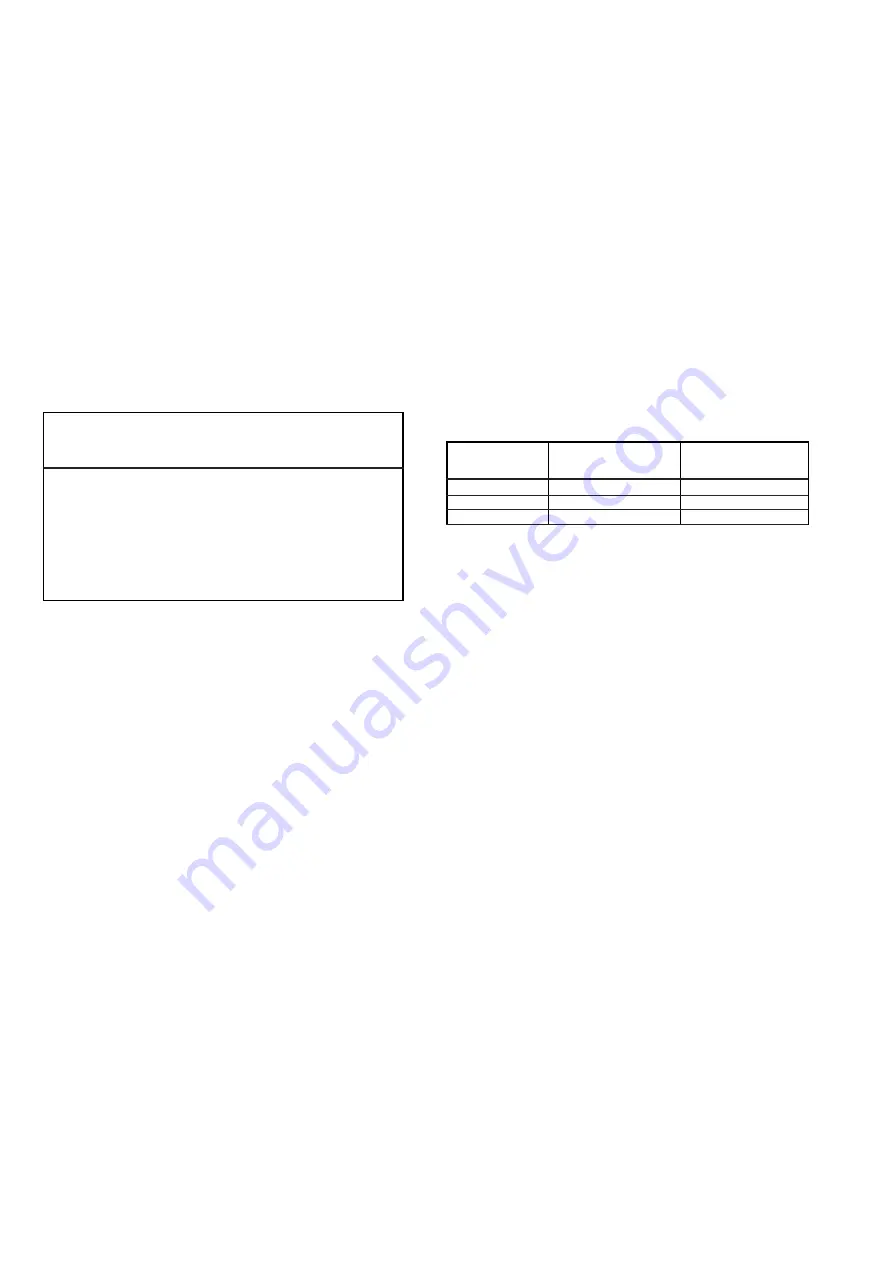
1 - 16
1.7.1 I
2
C Bus, IC Test
In this fault finding programme, the CIC80050 processor scans the
individual modules or circuits connected to the I
2
C bus and indicates
them as countable flashing sequence on the LED of of keyboard
control unit.
Press and hold down "P+" on the TV set and switch the TV set on with
the mains button.
The number of flashing pulses indicates the defective module according
to the table.
Flashing sequence example:
red LED flashes quickly for 10s
yellow LED lights for 4s
green LED flashes (e.g. 2 times) = tens's place (2)
green LED lights for 4s
green LED flashes (e.g. 8 times) = units's place (8)
Result
= 28
With the "
Ƿ
" button on the TV set is is possible to find out further
defective interfaces.
IC
Flashing
Defective module/
designation
frequency
integrated circuit
CIC31010
1
Signal Module
CIC70200
2
Feature Module
CIC70250
3
Feature Module
CIC70300
4
Feature Module
CIC33010
5
Signal Module
IC43140
6
Signal Module
TUNER
7
Signal Module
CIC32040
8
Signal Module
2. Special Functions in the "Installation" Menu
2.1 Visible or Unvisible "Sound scale" for all Programmes
Call up the "Sound scale" menu via "
Info centre
" –> "Installation" –>
"Special functions".
With "off" selected, no volume bar is displayed.
2.2 Switching on with Programme "1", or automatically
Call up the "Switching on " menu via "Info centre" –> "Installation" –>
"Special functions" .
Set the option "Programme position "1" or "automatic".
With the "automatc" setting, the programme position selected when
switching off is selected again when switching the set on again (Last
station memory).
2.3 "Masterlink info"
(only if the Masterlink feature is identified)
Call up the "Masterlink info" menu via "Info centre" –>
"Installation" –> "Additional settings".
The Masterlink control can be switched to "on" or "off".
2.4 Status display
Call up the "Status indication" menu via "Info centre" –>
"Installation" –> "Additional settings" .
You may select the position (top or bottom) where the information
about the sound mode and the picture format is displayed.
With the "off" option, no information is displayed when changing the
programme.
2.5 Automatic volume
Call up the "Automatic volume" menu via "Info centre" –>
"Installation" –> "Additional settings".
In the "ON" position, the sound IC regulates the volume internally to the
normal value (e.g. increased deviation in the case of advertising).
2.6 Noise reduction P1…99 or P1…199 (with SAT module)
Call up the "Noise reduction P. 1…99" menu via "Info centre" –>
"Installation" –> "Additional settings". For the
programmes 1…99
or
1…199 you may set the noise reduction to "off", "low" or "automatic".
With the "manual" setting, the display indicates that one or several
programmes have different settings.
2.7 Sharpness P1…99 or P1…199 (with SAT module)
Call up the "Sharpness" menu via "Info centre" –>
"Installation" –> "Additional settings".
The picture sharpness is set for all programmes.
2.9 Colour match
Call up the "Colour match" menu via "Info centre" –> "Installation" –>
"Additional settings" (to page 2).
The colour match (luma delay) is set for every programme.
On sets with PIP module, the colour match for the PIP picture can be
set individually.
3. Format Switching
3.1 Format Switching with Evaluation of the Switching Voltage
Depending on the voltage present on Pin 8 of the active EURO-AV
socket, the set adjusts the picture format. In AV mode, the picture
format switching is active for the AV socket (AV 1, AV 2, AV 3).
With 4:3 picture tubes
Picture format be- New picture format after New picture format after
fore voltage change Pin 8: 0/12V –> 6V
Pin 8: 6V –> 0/12V
16:9
-
old format *
4:3
16:9
old format *
Panorama Zoom
16:9
old format *
* old format means the format adjusted manually before the last voltage
change.
4. Service Settings for the Retailer
4.1 Picture Screen Geometry
Call up the "Picture screen geometry" menu via "Info centre" –>
"Installation" –> "Dealer service menu" –> "8500".
Align the geometry test pattern beginning with the vertical alignment
(see alignment point 11).
4.2 Picture Settings
4.2.1 White Balance
Call up the "White balance" menu via "Info centre" –> "Installation" –
> "Dealer service menu" –> "8500" –> "Picture settings".
Adjust the values for "red", "green" and "blue" so that a white picture
is obtained. (See Alignment, Point 8).
4.2.2 Switching the Blue Screen Background On and Off
Call up the "Blue Screen" menu via "Info centre" –> "Installation" –>
"Dealer service menu" –> "8500" –> "Picture settings".
Select "on" or "off".
4.3 Special Functions
4.3.1 Watchdog On/Off
Call up the "Watchdog" menu via "Info centre" –> "Installation"
–> "Dealer service menu" –> "8500" –> "Special functions".
If the Watchdog timer is not reset in regular intervals, a new start is
initialized.
Set the Watchdog to "off" or "on".
4.3.2 IR-Dataprogrammer (only with terrestrial module)
Call up the "IR-Dataprogrammer" menu via "Info centre" –> "Installation"
–> "Dealer service menu" –> "8500" –> "Special functions". Using the
"OK" button, it is possible to store up to 99 programme positions with
data for channel, TV standard, Peri, 6-position station name, centre
fine tuning, and "0" volume offset, with the help of the IR data
programmer.
The Programmer AP transfers only the 6-position station name with
centre fine tuning and "0" fine tuning offset.






























